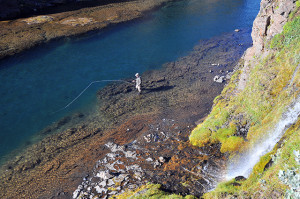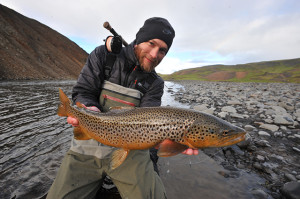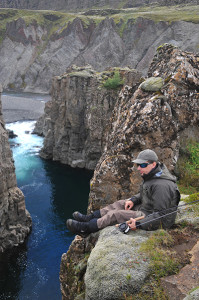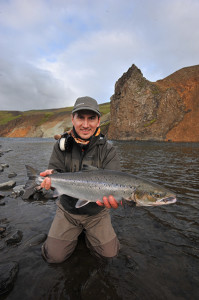Words By: Rasmus Ovesen
Photos By: Rasmus Ovesen and Martin Ejler Olsen
Iceland boasts some of Europe’s most beautiful and productive salmon rivers, and Stora Laxa is among the very finest.
I SEND ANOTHER EXPECTANT CAST out over the river’s fluttering and glass-like film. The small # 14 Sun Ray Shadow lands with a discrete “plop” near the opposite bank and weighs itself down into the water column, before the current and the first retrieves hitch it up and make it rear towards the surface. The river valley’s steep and lush-green expanses mirror themselves subduingly in the water and flickers in competition with the skies’ abysmal blue. Meanwhile, the volcanic landscape’s majestic and dramatic surroundings sort of intrude – welcomingly, hypnotic and reconciling. It is a heartrending beautiful place, but I don’t have the peace of mind to fully appreciate it – not yet at least. My ailing salmon fly fishing career, that has never really gotten off to any kind of fair start, requires my full dedication, and every fateful cast with the light #5 single handed fly rod is charged with the greatest of concentration and the most intense hopes imaginable.
After several fruitless trips to more or less doubtful Norwegian and Swedish salmon rivers, I have ventured to the river, Stora Laxa, in Southern Iceland to realise my chrome salmon fly fishing dreams.
It is still rather early in the season but, already, impressive amounts of fish are heading up river – amounts so massive that I can hardly believe that they are going to intensify. They undoubtedly will, however, especially later this month and all through September. By then every pool will be teeming with activity.
A couple of days ahead of my arrival, two local Icelandic fly fishermen have caught several shiny chrome fish – many of them with sea lice, so everything seems promising enough. The fact that I’m still a slave to my feelings; marked by too many salmon fishing trips without a trace of salmon and a thinly worn sense of self-confidence is an entirely different matter. As fate will have it, I will overcome all of this in due time…
A CROSS-CURRENT CAST followed by a quick line mend now guides the fly through a riffle, where the water is being accelerated over big and defiantly resting boulders. My gaze is firmly fixed on the end of the line, and even before I feel the cathartic pull, I see how it suddenly holds back a bit – defying the water’s gushing flight downstream. Slightly mechanic, I lift the rod and instantly feel the weight of a fish that has just clamped its jaws around the minute fly. Hectic flashes of silver in the surface follow as the salmon attempts to throw off the hook with ill-tempered slaps of the tail and violent rolls. It doesn’t help much, though. The fish is solidly hooked, and several tumultuous airborne leaps with abrupt, collision-like landings won’t alter the outcome of the battle, which is soon to be over.
As if driven by an invisible force, the fish is reluctantly guided into the rocky shallows where it finally capsizes. Here, it lies defeated for a short while with quivering muscles under a chrome skin overstrewn with contrasting black spots. Split seconds later, I manage a good grip around the root of its tail. It is no monster fish, but the euphoria is unmistakable. My first Icelandic salmon is a reality: a compact Stora Laxa fish of about three beautifully proportioned kilos, which – like a combat-ready knight – has adorned its shiniest armour. A more stylish and elegant fish is hard to imagine!
The indignant fish is carefully released with plenty of raw muscle power to spare for the on-going migration upstream – and with a roaring warmth in my body, renewed self-confidence and lots of adjusted drive I start ripping line off the reel and preparing for new casts. Five days of fishing on the river’s four different beats await, I have just started warming up, and I still have no clue about the extent to which this river will end up spoiling me.
THE NEXT FIVE DAYS, my buddy Martin and I fish some of the most spectacularly beautiful rivers, we have ever seen – and we catch more salmon than even the most persistent Scandinavian salmon fisherman is likely to catch in a full season, even Alaskan sockeye sometimes. Furthermore, we make close encounters with some indomitably fighting and hypnotically beautiful brown trout and arctic char in full-grown sizes – fish that throw themselves at our flies, when we least expect it.
From Beat I and II’s numerous gentlemen pools – where everything from the river access to the wading and fishing is unproblematic and convenient – we now journey further upstream. By now, we have become relatively experienced in controlled drifts with small hitch- and standard tube flies, and we are ready to try some of the more challenging pools on Beat III and IV. Up here, the amounts of salmon are more moderate, and as a result, the pending work will not limit itself to climbing steep cliffs and canyons, hike through rolling terrain and wade in heavy currents. It will also involve tireless efforts in terms of locating the fish and actually inducing some heady strikes. Not surprisingly, we struggle quite a bit with the latter, because the pools in this abstruse and remote area are as difficult to read, as they are impeccably beautiful and enthralling.
The fact that the Stora Laxa salmon are generally quite aggressive becomes our rescue. Because even though we are treading uncertain waters, we still manage to find some huddled schools of salmon in a few seams, pools and eddies. One of the spots, where we consistently have great fishing is the Heljathrem pool on Beat III. Here, a monumental rust-red cliff towers above a fast run with relatively deep water and lots of cover. The pool itself is rather small, but it must have a special magnetism on the fish. Because even though the fish on Beat III and IV seem especially keen on travelling further upstream towards the spawning grounds, the Heljathrem pool consistently holds smaller schools of fish. Why they defy their impulse-driven urges to push upstream and settle here in stead is difficult to say. It is definitely no interval of rest, however, because the fish are constantly chasing each other around and becoming more and more stressed and aggressive.
In order not to disturb the pool too much, we only fish it early morning and late evening. Everything seems completely self-explanatory here, and for the last three days we hook up with several chrome fish in the six-kilo range that push our light single-handed equipment to the maximum. For me, the fishing here comes to epitomize the essence and allure of salmon fly fishing. No mysticism or hocus-pocus is involved, no underlying uncertainties or unresolved speculations! As long as we swing our small tube flies cross-current at a slow pace, the strikes follow with the greatest of obviousness and truism – like meaningful surface explosions of flickering silver and chrome.
STORA LAXA, which is undoubtedly among Iceland’s most beautiful rivers, hasn’t got a reputation for delivering catches of downright monster salmon. (This isn’t really true for any of the Icelandic rivers). Instead, there are massive amounts of fish from the beginning of August until October, where the season comes to a closure. The average size of the fish usually lies somewhere between three and four kilos, and when the fishing is really good, you frequently connect with contentious bundles of muscles in the six-kilo range. Catching these fishes is extremely entertaining, and catching them in generous amounts never gets tiring. However, if you’re one of those salmon fly fishermen, who have a propensity for big fish, it is comforting to know that – with a bit of luck – Stora Laxa salmon up to 15 kilos can be caught, and that 10-kilo fishes are landed with regular intervals in the high season. Salmon in this calibre put up a bitter and heated fight, and that is exactly what I get, when I fish a promising pool on Beat 1 and come into contact with one of the river’s big fish – a fish that ends up etching itself onto my memory.
ALREADY AFTER A FEW HANDFUL OF CASTS comes the strike – like lightning from a clear sky. A crackling chrome shape flashes behind the fly, and suddenly the fly line becomes critically taught. I lift the rod tip, set the hook and feel the trembling counterweight of a fish that surges irresistibly back towards its holding spot along the river’s craggy bottom. A series of brutal pulls propagate through the blank, like series of deep carbon fibre-cramps followed by a sudden and blunt dead-weight. The fish cannot be budged – and I suddenly find myself worrying about the fish being fowl-hooked. No matter what, I need to force the fish away from the sheltering bottom textures and into the free water masses – but the question is whether or not the light #5 gear, the 0.30mm tippet and the frail #14 treble hook will be up for the task. I apply whatever side-pressure I can and pull heavy-handedly back on the fish until the cork handle squeaks and the line sings cacaphonically in the guides and finally – after a bit of toing and froing back and forth – the fish yields. It moves into the main current, surges bewildered downstream and throws itself headlong out of the water with the small Sun Ray Shadow firmly lodged in its glistening gums. Now, the fight is truly on!
The fly line cuts through the river’s fleeting water masses with surgical precision carefully mapping the fish’s escape route. After having given up the false security of the holding spot it thrusts itself down river with violent strokes of the tail and with me rushing behind in hot pursuit over slippery rocks. Further downstream, the river and the terrain suddenly drops, the water accelerates dramatically – and foaming water whirls and gushes downwards licking big and dangerously rugged boulders. It is pivotal that I prevent the fish from getting there. To avoid this potential catastrophe, I need to apply some serious side pressure, so I opt to run swiftly downstream, while doing my best to pick up slack line and keep the fish on a tight leash.
Immediately above the cascade I manage to turn around the fish, which now changes tactics and starts rolling chaotically in the surface film. Slowly but surely I bring the fish towards land, where Martin is ready to assist with the landing. A lot can still go horribly wrong because the fish isn’t really tired yet, and every time it rolls bewildered in the surface, it is being carried further downstream, where the frothing water masses of the cascade awaits. It is now or never, so I push the gear to the limit, bring the fish into the shallows and in his second attempt, Martin manages to grab the fish by its massive tail and drag it onto the bank. Here, we celebrate and marvel at an immaculate and beautiful 97cm hen, which has to weigh 10+ kilos. I carefully lift up the iridescent chrome fish for a couple of quick photos and immerse it into the water, where it quickly regains its full strength. A sizzling warmth flushes over me as the fish makes its way into deeper water and becomes one with the river again. I’m left with a sudden appreciation and understanding of what salmon fishing is really about. All the work – every neat cast, every tense retrieve, and every watchful glance is charged with the greatest of meaningfulness. I have lost my soul to salmon fly fishing and not least to Stora Laxa – the place, where even the most disheartened salmon fisherman can find renewed self-confidence and get to experience what salmon fishing is essentially about.
STORA LAXA
The Stora Laxa River in the southern corner of Iceland is administered bythe Icelandic salmon fisherman, Arni Baldursson, and the company Lax-A (www.lax-a.net). Lax-A disposes over 40 kilometres of the StoraLaxa River, which is a tributary to the massive glacier river Ölfusá. A total of ten rods are available on the four beats: 4 on Beat I and II, which are rented out together, 2 on Beat II and 4 on Beat IV. Depending on the beat and the season, a rod costs between 250 – 700 Euros per day and it includes accommodation in one of the big, comfortable and well-equipped self-service cabins that belong to each beat. These cabins sleep up to 12 guests, and they are right on the river bank, which means that they work very well as a starting point for the fishing.
Stora Laxa is a medium-sized and extremely clear river that is well suited for light single-handed and double-handed fly fishing. It is among the 10 most productive salmon rivers in Iceland, and in the 2013 season an impressive 1776 salmon were landed – which is in the vicinity of 2,5 salmon per rod/day. In the main season, which stretches from August to the end of September, daily catches of up to 10-15 salmon aren’t unusual. At this time of year, there are massive amounts of fish in the river, and if your fishing coincides with some downpours and rising water levels, the fishing oftentimes explodes completely.
Additional info can be had by contacting Lax-A via email: lax-a@lax-a.is





